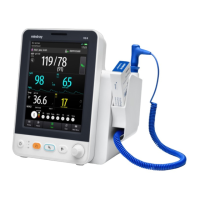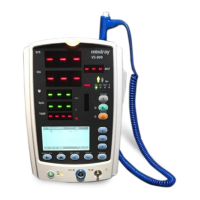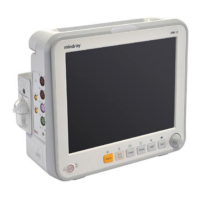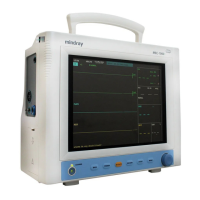• All network functions of data communication are designed to operate on a
private network.
A.5.8.1 System Capacity
Number of the monitors supported by a single AP: ≤ 16
Testing conditions are as follows:
■ Each monitor can communicate with the CMS.
■ Only one monitor can transmit history data.
■ The weakest strength of the AP signal where the monitor is located cannot be less
than -65 dBm.
A.5.8.2 Resistance to Wireless Interference
The distance between the interfering devices and the monitor is greater than 20 cm. A
Wi-Fi interference (no greater than -85 dBm) in the same channel and a Wi-Fi
interference (no greater than -50 dBm) in an adjacent channel are presented
synchronously. The interfering devices include 2.4 GHz wireless devices, cellular mobile
networks, microwave ovens, intercoms, cordless phones, and ESU equipment. The
interfering devices do not include Wi-Fi devices.
Standards IEEE 802.11a/b/g/n/ac
Modulation mode BPSK, QPSK,16QAM, 64QAM, 256QAM
Operating
frequency
2412MHz~2462MHz,
5180MHz~5320Mz, 5500MHz~5700MHz, 5745MHz~5825MHz
Wireless data rate IEEE 802.11a: 6-54 Mbps
IEEE 802.11b: 1-11 Mbps
IEEE 802.11g: 6-54 Mbps
IEEE 802.11n: MCS0-MCS7
IEEE 802.11ac: MCS0-MCS8
Output power <20 dBm (CE requirements, detection mode: RMS)
<30 dBm (FCC requirements, detection mode: peak power)
Working mode Infrastructure
Data security Standard: WPA/WPA2-PSK, WPA/WPA2-Enterprise, WPA/WPA2 CCKM
EAP method: LEAP, EAP-TTLS, EAP-TLS,EAP-FAST, PEAP-MsChapV2,
PEAP-GTC, PEAP-TLS
Encryption: AES
• When equipment works at 2.4GHz, in the application scenario, the most
serious interference source is other 2.4GHz Wi-Fi devices that not sharing the
same network with equipment and LTE devices. When equipment works at
5GHz, the most serious interference source is other 5GHz Wi-Fi devices that
not sharing the same network with equipment.
• To make sure equipment works well, user should make sure the separation
distance between equipment or the AP that equipment is connecting and the
Unintended interference devices be longer than the distance showing below:
Frequency
band
Unintended signals Separation distance
between the
monitor and the
interference devices
Separation distance
between the AP and
the interference
devices
2.4GHz WiFi
(2412-
2462MHz)
Adjacent channel 1
and 11(802.11n)
0.2m 1.0m
Co-channel 2.5m 4.0m
lower adjacent band
LTE of 10MHz
0.2m 0.5m
upper adjacent band
LTE of 10MHz
0.2m 0.5m
Adjacent channel 1
and 11 (802.11n),
lower adjacent band
LTE of 1.4MHz,
upper adjacent band
LTE of 1.4MHz
0.2m 1.0m
lower adjacent band
LTE of 10MHz,
upper adjacent band
LTE of 1.4MHz and
Adjacent channel
6(802.11n)
0.2m 0.5m
5GHz WiFi
(5190-
5210MHz)
Adjacent 2.0m 4m
Co-channel 7.0m 8.5m

